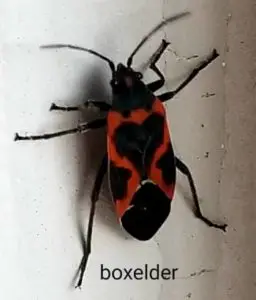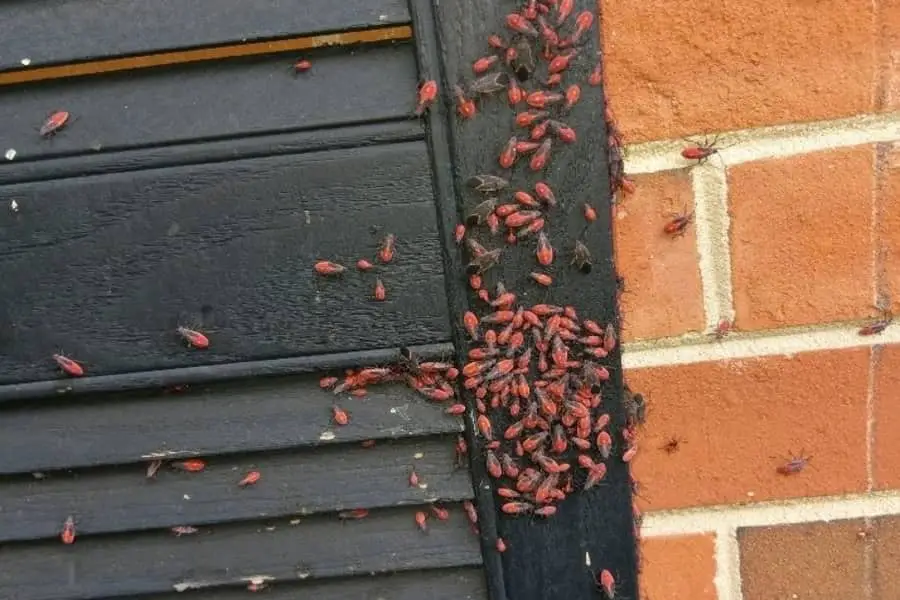When I first saw the black and red bugs and before I became a bug guy, I wondered what they were called. After some research, I was able to find their name and their behaviors.
So what are these black and red bugs in my house? Boxelder bugs (boisea trivittata) They get their name from the tree they can be found on, the boxelder tree (Acer negundo). Boxelder bugs are a nuisance pest they will swarm buildings, homes, sheds, and vehicles in their pursuit for warmth to over-winter in the fall. Boxelder bugs stay in these places through the winter.
What Do Boxelder Bugs Look Like?
Boxelder bugs are about a ½ inch long. The adults are black with red slender line patterns on their back. The nymphs or youth are solid red or orange. It is easy to confuse a boxelder nymph with a milkweed bug. One way to tell is in the bug behavior.
Where Do Boxelder Bugs Come From?
Female boxelder bugs will lay their eggs in between the bark of a boxelder tree. When the eggs are laid they will be a yellowish color, after 2 weeks the eggs turn red and the boxelder nymphs are born.
What Do Boxelder Bugs Do?
Boxelder bugs will feed of female Boxelder trees when they seed in the spring they also can be found on maple or ash trees. Boxelder bugs can also be found feeding on other plants.
Boxelder bugs will eat the seeds and suck the juice that the tree provides, they will later eat on leaves and fallen fruits from fruit trees.
Boxelder bugs love the sun in the warmer months you can find them soaking it in on the south facing azimuth of all kinds of buildings, homes, and sheds. They will lay their eggs between the bark of the trees to protect the eggs.
Migration
Spring Behavior – After hibernation boxelder bugs will emerge from overwintering. They flock to their host tree.
Fall Behavior – As the hot summer heat begins to fade and the cooler weather settles in, boxelder bugs begin their search for warmer places to stay. Boxelder bugs are now looking for homes, sheds, and buildings that will provide them with warmth they need to last the winter months.
Why Are There So Many Boxelder Bugs?
The reason that boxelder bugs are so abundant is that they don’t have predators that like to eat them. They have an awful odor which makes them unattractive for birds, spiders, and other insects to feed on them.
Are Boxelder Bugs Dangerous?
Boxelder bugs are harmless. They are a nuisance bug that does not bite or cause structural damage. They are known to stain drapes, and walls when they make their way inside your home.
How Do I Prevent Boxelder Bug Invasion?
Spray the outside walls of your home in fall with a pesticide to hinder them from hiding in your home for the winter.
Try to treat earlier in the year, in the spring-summer that is the best time to treat while the boxelder bugs are leaving the home to venture out. If you have boxelder problems it would be in your best interest to treat 2 times in the year spring and fall.
The other reason it is good to treat for the boxelder bugs 2 times a year is that even though you spray a lot of times you still won’t get a 100% kill. The spray generally only takes care of 90% of the bugs.
You can also use an insecticide spray around the baseboards and window seals on the interior of the home to further the control the bugs.
If Boxelder bugs make it inside your home during the fall to winter months. You will not be able to control them fully. Interior spray should be the last line of defense however because it won’t stop the bugs from coming into the home. The boxelder bug will eventually die after it comes into contact with the insecticide.
Choose The Right Application For Boxelder Control
Dishwashing Soap – If you decide hey I want to treat these guys cheap and on my own, you can mix 2 oz. of dish soap with 1 gal. of water and put that in a spray can. The good news is any boxelder bug you spray will die. The soap drys the boxelder bug’s waxy exoskeleton layer and causes breathing disruption which in turn kills them. The bad news is there is no residual effect in using this method. You will need to do this many times before you will see major results on large boxelder infestations.
Mechanical Treatment – This is where you will seal off your home with silicone around the windows and doors, any breaks in the siding, and any HVAC pipes and drain pipes going in or coming out from the outside. Make sure all screens to windows, attics are tight and secure. If you have a crawl space make sure the door isn’t warped and that it fits snug.
Chemical Treatment – Cyfluthrin- is going to be your best friend. Tempo Dust can be applied using a bellows duster and a spider web busting broom. An application should add .5 oz. of tempo on the web buster and treat around all windows, doors, eaves, soffits, fascia, downspouts, and gutters on the bottom side. Note: After a rainfall, the dust will dissipate when exposed to the elements. I never do this treatment in the rain or when it is snowing.
Lambda-Cyhalothrin– is a liquid treatment. It has a long residual because of its microencapsulation technology. Demand CS can be applied by using a one-gallon spray can and 0.5 oz. of Demand CS. Before you pump the can make sure that you shake it well after replacing the top. You will want to spray around all windows, doors, eaves, soffits, fascia, downspouts, and gutters on the bottom side. You can also spray all cracks and crevices.
Bifenthrin – is a cheaper option than the lambda-cyhalothrin. It lasts up to a month before the chemical is broken down. Bifenthrin is human-friendly and can be sprayed out of a 1-gallon spray can with 0.5 oz of chemical per gallon of water.
*Because you are using such a small amount of chemical when you purchase these products you will have them for years.
*I’ve found that vacuuming along with the mechanical and chemical treatments are very effective in the control of boxelder bugs. DON’T SMASH THEM… They leave a stain if you squish them on your drapes, rugs or upholstery.
You should always read the label of any chemical you decide to use and apply it in that manner. Make sure to always wear protective gear when applying pesticides, the label will say what should be worn to apply that specific pesticide.
Questions Often Asked:
What Do Exterminators Do To Stop A Mouse Problem?
I had a friend recently tell me his wife saw a mouse in their basement and he wondered if he should just set up traps or call an exterminator. He said he didn’t want to pay someone $300 dollars just to set a mouse trap.
So he googled… What do exterminators do to stop a mouse problem? Most Pest Applicators use poison to stop a mouse problem. If you are not a pesticide person and you don’t mind disposing of mouse carcasses traps work too. There is, however, a refined technique that should be implemented.
The most common places you will find mice will be:
 Under Sinks
Under Sinks- Around Water Heaters
- Under The Refrigerator
- Under The Stove/ Range
- Behind Washer and Dryer
- Under The Dish Washer
- Crawl Spaces
- Unfinished Basements
- Attics/Walls
Can I Save Money Doing Pest Control Myself?
As a professional in the pest industry and having done this for many years I never got into the habit of talking to people about doing pest control themselves, that would be a conflict of interest. I looked online and didn’t find many good resources that show people how to do it or where to treat to get the best results. So I felt it my duty to share this with you.
So can you save money doing pest control yourself? In a word, yes! Doing pest control yourself, in the long run, will be much cheaper. There is an initial cost for reusable items like sprayer, gloves, and chemicals but the pesticides used will go a very long way.

